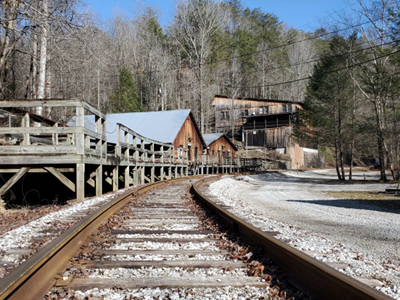The Big South Fork National River and Recreation Area is comprised of 125,310 acres located within the Cumberland Plateau in eastern Tennessee and Kentucky. Over time, erosion has created many spectacular geological formations including natural bridges, magnificent bluffs and beautiful gorges. The Big South Fork Area is home to more natural bridges and stone arches than anywhere else east of Colorado and Utah, and is often called “The Yellowstone of the East” with approximately 600,000 visitors annually. One of the most unique ways to sight see through this majestic landscape starts in the historic Trail Town of Stearns, Kentucky.


Stearns was established in 1902 when Justus Stearns, one of the last lumber barons on the Great Lakes, bought 130,000 acres of virgin forest in southern Kentucky. The town of Stearns became the center of an empire that covered 200 square miles of timber and mining operations. Construction of the Kentucky and Tennessee Railroad began in 1901 and was used by the Stearns Lumber Company out of Ludington, Michigan to transport lumber. During construction of the railway, a seam of coal was discovered near the area we now know as Barthell. The Stearns Lumber empire expanded their business and soon became known as the Stearns Coal and Lumber Company. Today, this quaint town is the first stop travelers often make so that they may ride the 16 mile round trip on the Big South Fork Scenic Railway. This heritage railway is a one of a kind experience and hosts numerous themes throughout the year, including the Polar Express around Christmas. On average, approximately 22,000 people travel annually to Stearns to ride the railway. With a population of only 1,190, a vast majority of the area’s economic growth is dependent on tourism.
Barthell was established in 1902 and was the first of 18 mining camps to be built by the Sterns Coal and Lumber Company and is the first stop made by the BSFSR tour. By 1909, it consisted of approximately 350 residents with 41 dwellings including a motor house, bath house, community store, tipple, school/church, post office, 15 one and two bedroom houses, barbershop and doctor’s office. The decline of Barthell began in 1943 when the tipple at Mine No. 1 was destroyed by fire and was never rebuilt. Mine No. 1 was also closed shortly after the fire at the tipple. Coal mined from Mine No. 2 was then sent to the tipple at Mine No. 18 at the Blue Heron Mining complex. The dismantling of the coal camp began in 1952 and was completed in 1961.

In 1984, the Barthell coal camp was purchased by the Koger family, who invested more than $500,000 of their own money into the revitalization of the community. Many of the community's original structures, such as the company store, doctors office, and school house have been renovated and can be toured. Fifteen former coal camp homes have also been renovated and can be rented for overnight stays.
Blue Heron, formally known as Mine 18, is another abandoned coal mining town that was part of the Stearns Coal and Lumber Company and is the last stop on the BSFSR tour. It operated from 1937 to 1962 before the buildings were removed or torn down. To preserve historical significance, the community was re-created in the 1980’s. Some of the original structures have been replicated as open, metal shells of buildings, referred to as "ghost structures," on the approximate sites of their original locations. Structures include a railroad depot, a full-scale model of the coal tipple, a school, and homes. Photographic exhibits and audio programs in the ghost structures tell about various aspects of life in the isolated mining community.
The establishment of the Big South Fork Scenic Railway was also a milestone in the park's early history. Run by the McCreary County Heritage Foundation, the train departs the historic Stearns Depot atop the river gorge and travels down to Mine 18. Visitors who ride the train don’t have to drive the winding road that leads into the depths of the canyon.